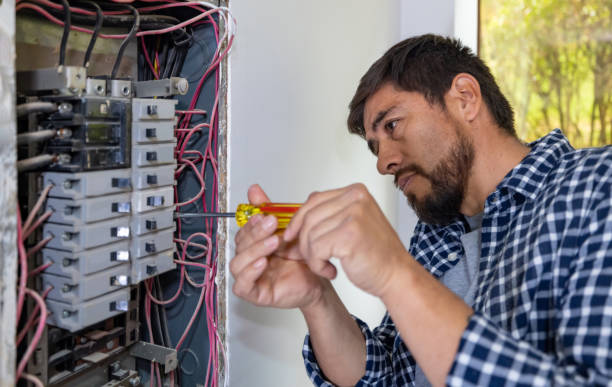Upgrading your home’s electrical system is a crucial step in ensuring safety, improving energy efficiency, and supporting modern appliances. Whether you live in an older home with outdated wiring or you’re planning a major renovation, updating your electrical system requires careful planning and professional expertise. This guide will walk you through the process and highlight how residential electrical services can simplify the task.
Why Upgrade Your Electrical System?
Before diving into the specifics, it’s important to understand why upgrading your home’s electrical system is necessary.
- Safety Concerns: Outdated wiring, such as aluminum or knob-and-tube wiring, poses a fire hazard.
- Energy Efficiency: Modern systems accommodate energy-efficient appliances and reduce electricity waste.
- Increased Capacity: Today’s homes require more power to support devices, lighting, and heating systems.
- Compliance with Codes: Electrical upgrades ensure your home meets the latest building and safety codes.
- Property Value: A modern electrical system increases the resale value of your home.
Signs It’s Time for an Upgrade
Not sure if your electrical system needs an upgrade? Here are some telltale signs:
- Frequent circuit breaker trips or blown fuses
- Flickering or dimming lights
- Warm outlets or burning smells near switches
- Insufficient power for appliances or electronics
- Two-prong outlets with no grounding
- Outdated electrical panel (less than 100 amps or missing a main breaker)
If you notice any of these issues, consulting residential electrical services is the first step in addressing potential problems.
Steps to Upgrade Your Electrical System
Upgrading an electrical system involves several steps, from assessment to installation. Let’s explore each in detail.
1. Assess Your Current System
Begin by assessing your current electrical system. Check the condition of your wiring, outlets, and panel. Consider your home’s power demands and how they align with your current system’s capacity. This stage often requires the expertise of a licensed electrician to identify hazards and inefficiencies.
2. Plan for Future Needs
Think about how your home’s electrical needs might evolve in the future. Are you planning to install solar panels, a home office, or electric vehicle charging? Factor these into your plans to avoid needing another upgrade later.
3. Upgrade the Electrical Panel
The electrical panel is the heart of your system, distributing power throughout your home. Many older homes have panels with limited capacity, such as 60 or 100 amps, which are insufficient for modern households. Upgrading to a 200-amp panel is often recommended to handle today’s power demands.
Residential electrical services can handle panel upgrades safely and ensure compliance with local codes.
4. Replace Outdated Wiring
If your home has old or unsafe wiring, such as aluminum or knob-and-tube wiring, replacing it is a top priority. Modern copper wiring is safer, more durable, and better suited to today’s electrical loads.
During this process, electricians may also add new circuits to reduce the risk of overloading.
5. Add Ground Fault Circuit Interrupters (GFCIs)
GFCI outlets are essential in areas prone to moisture, such as kitchens, bathrooms, and outdoor spaces. These outlets protect against electrical shock by cutting off power if they detect an imbalance.
6. Install Additional Outlets
Homes built decades ago often lack sufficient outlets for today’s technology-heavy lifestyle. Installing more outlets can reduce the need for extension cords, which can be a fire hazard.
7. Upgrade Lighting
Modern lighting options, like LED fixtures, are energy-efficient and long-lasting. Upgrading your home’s lighting can reduce your electricity bills and improve your living environment.
8. Surge Protection
Installing whole-house surge protectors safeguards your electronics and appliances from power surges caused by storms or utility issues.
9. Smart Home Integration
Consider integrating smart home technology, such as programmable thermostats, smart outlets, and automated lighting. These devices improve energy efficiency and convenience.
10. Inspection and Final Testing
Once upgrades are complete, a licensed electrician will inspect and test the system to ensure it’s functioning safely and efficiently.
Why Hire Professional Residential Electrical Services?
Upgrading an electrical system is not a DIY project. Electrical work is complex and potentially dangerous, requiring specialized knowledge and tools. Here’s why hiring residential electrical services is the best choice:
- Safety: Licensed electricians follow strict safety protocols to prevent accidents and ensure compliance with codes.
- Expertise: Professionals have the training and experience to handle complex tasks like panel upgrades and wiring replacements.
- Time Efficiency: Hiring a pro saves time, as they can complete tasks quickly and correctly the first time.
- Code Compliance: Electricians ensure all work meets local building codes, avoiding fines or issues during a home sale.
- Warranty: Many electrical services offer warranties on their work, giving you peace of mind.
Cost of Upgrading an Electrical System
The cost of upgrading an electrical system varies depending on the scope of work, the age of your home, and your location. Here’s a general breakdown:
- Panel Upgrade: $1,500 – $3,000 for a 200-amp panel
- Rewiring: $8,000 – $15,000 for a full-home rewire
- Outlet Installation: $100 – $200 per outlet
- Lighting Upgrades: $50 – $200 per fixture
While these costs can seem high, the investment pays off in improved safety, efficiency, and home value.
Maintaining Your Upgraded System
Once your electrical system is upgraded, regular maintenance is key to ensuring its longevity.
- Annual Inspections: Schedule yearly inspections with residential electrical services to identify and address issues early.
- Test GFCIs: Test GFCI outlets monthly by pressing the “test” button to ensure they’re functioning.
- Monitor Energy Use: Use smart devices or energy monitors to track your electricity usage and identify ways to save.
Conclusion
Upgrading your home’s electrical system is a critical investment in safety, efficiency, and modern convenience. From replacing outdated wiring to installing smart technology, the process requires careful planning and expert execution. By enlisting professional residential electrical services, you can ensure the job is done safely and to the highest standards, giving you peace of mind and a home equipped for the future.


